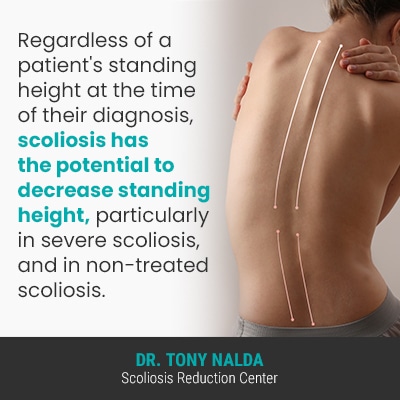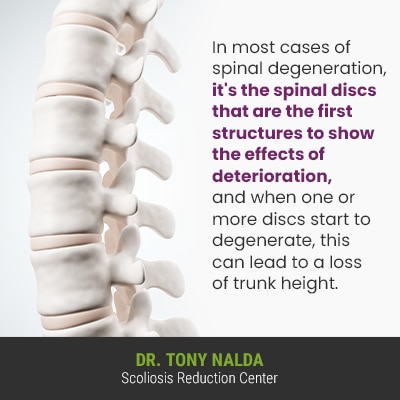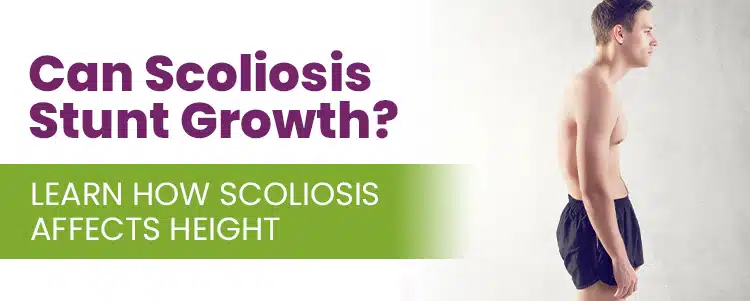While scoliosis is a structural spinal condition, its effects can be felt throughout the body. Scoliosis can even affect a person’s height by causing a loss of the spine’s natural curves and alignment, which disrupts a person’s ability to stand up straight and fully extend the spine.
As an unnatural sideways spinal curve, with rotation, scoliosis introduces a lot of uneven forces to the body, and those uneven forces can disrupt the body’s overall symmetry. When scoliosis causes postural deviation, it can make it harder to stand up straight, thus the person loses trunk height.
Let’s first explore the general connection between spinal anatomy and height, before specifying how scoliosis can affect height.
4 Key Takeaways
- Scoliosis and Height Impact: Scoliosis, characterized by an abnormal sideways curvature of the spine with rotation, can affect a person’s height by disrupting the spine’s natural curves and alignment, making it harder to stand straight and extend the spine fully.
- Variability in Severity: The extent of height impact varies with the severity of scoliosis. While mild cases may see minimal effects, more severe forms of scoliosis are likely to result in a more noticeable loss of height due to the curvature’s distortion of spinal alignment.
- Types of Scoliosis Influencing Height: Neuromuscular and degenerative scoliosis are particularly associated with height loss due to their impact on spinal support structures and disc integrity, influencing the spine’s ability to maintain its length.
- Potential for Restoration with Treatment: Proactive, non-surgical treatment approaches, especially those started early, can work towards correcting the scoliotic curvature on a structural level, potentially restoring some of the height lost due to scoliosis.
Anatomy of the Spine and Height
The spine consists of vertebrae (bones of the spine) stacked on top of one another in a neutral and straight alignment, and the majority of people have 33 vertebral bodies.
If viewed from the front or back, a healthy spine will appear straight, and if viewed from the sides, it will take on a soft ‘S’ shape; it’s the spine’s natural/healthy curves that make it stronger, more flexible, and better able to absorb stress incurred during movement.
In addition, the spine makes it possible for us to stand upright and practice good posture.
The spine’s vertebrae are separated by intervertebral discs, and these discs play key roles in spinal health and function; they provide cushioning between adjacent vertebrae, combine forces to make the spine more flexible, give the spine structure (adjacent vertebrae attach to the disc in between), and act as the spine’s shock absorbers.
Healthy spinal discs affect spinal height because once one or more discs start to deteriorate, it affects the vertebrae, causing friction with movement, and spinal degeneration.
If the spine loses one or more of its healthy curves, its overall function and health is adversely affected.

Regardless of a patient’s standing height at the time of their diagnosis, scoliosis has the potential to decrease standing height, particularly in severe scoliosis, and in non-treated scoliosis.
So now that we’ve discussed general spinal anatomy and height, let’s move on to exploring the different severity levels of scoliosis, and related symptoms, such as a loss of height.
Let’s move on to discussing the severity levels of scoliosis and related symptoms, such as a loss of height.
Scoliosis Severity
Part of the reason scoliosis is so often deemed a complex condition is because it ranges so widely in severity from mild to very severe.
Condition severity is an important factor when it comes to symptoms, and while each case is different, the more severe a condition, the more likely it is to cause noticeable symptoms, such as a change to body height.
A patient’s Cobb angle is a measurement taken during X-ray that tells me how far out of alignment a scoliotic curve is making the spine, and further classifies conditions based on severity:
- Mild scoliosis: Cobb angle measurement of between 10 and 25 degrees
- Moderate scoliosis: Cobb angle measurement of between 25 and 40 degrees
- Severe scoliosis: Cobb angle measurement of 40+ degrees
- Very-severe scoliosis: Cobb angle measurement of 80+ degrees
As you can see from the wide range of Cobb angle measurements, no two patients are going to experience their condition the same way, particularly in terms of its symptoms; symptoms will be case-specific, as are treatment needs.
So while one patient might have cosmetic concerns about height loss related to their scoliosis, the next patient might not experience the same symptoms, particularly in mild forms.
Now that we have addressed the different severity levels of scoliosis, and understand that severity helps shape a person’s experience of life with their condition, let’s address some different condition types and height loss: idiopathic, neuromuscular, and degenerative scoliosis.
Idiopathic Scoliosis and Height Loss
The condition’s most-prevalent type is adolescent idiopathic scoliosis (AIS), diagnosed between the ages of 10 and 18.
In adolescent idiopathic scoliosis patients, it can be challenging to monitor height loss and/or height gain due to growth compensation as this age group is in, or is entering into, the stage of puberty, characterized by rapid and unpredictable growth spurts.
Ultimately, as growing spines are experiencing a constant lengthening motion, the direct link between adolescent idiopathic scoliosis and a loss of height is unclear; in other forms, however, the connection is clearer.
Neuromuscular Scoliosis and Height Loss
In cases of neuromuscular scoliosis (NMS), scoliosis develops as a secondary complication of a larger neuromuscular condition such as spina bifida, muscular dystrophy, and cerebral palsy, to name a few.
My NMS patients are among the hardest to treat because the underlying cause of the scoliosis has to be the guiding force of treatment, complicating the treatment process.
While it is affected by severity, neuromuscular scoliosis has a lot of potential to affect height because particularly in severe forms, NMS patients can become non-ambulatory, meaning wheelchair-bound and being unable to move without assistance.
While an actual loss of height is different from being non-ambulatory, it does impact a person’s ability to stand up straight (standing height), and over time, sitting height can change; the constant pressure on the spine from sitting can contribute to a loss of vertical spinal height.
Degenerative scoliosis is also known to affect height, and after idiopathic scoliosis, degenerative scoliosis is the most common type to affect adults.
Degenerative Scoliosis and Height Loss
Degenerative scoliosis is most common in adults over 40 and is more common in women due to bone density and hormone-level changes related to menopause.
While there is a natural degree of spinal degeneration expected with age, certain lifestyle choices can increase the rate of degeneration: carrying excess weight, chronic poor posture, repeatedly lifting heavy objects incorrectly, and leading a sedentary lifestyle.

In most cases of spinal degeneration, it’s the spinal discs that are the first structures to show the effects of deterioration, and when one or more discs start to degenerate, this can lead to a loss of height in the trunk.
The discs consist of two main parts: a tough, durable outer layer (annulus) and a soft gel-like interior (nucleus).
When a disc deteriorates, its shape can change, it can lose height, and this affects the positioning of adjacent vertebrae, making it difficult for the spine to maintain its natural curves.
The intervertebral discs are the largest structures inside the body without their own vascular supply, meaning they can’t restore and replenish themselves, and once they change shape and lose height, this can lead to a loss of spinal length.
Now that we know how scoliosis can affect the spine, in terms of its vertical height, can a scoliotic deformity correction, via successful treatment, cause a spinal height gain?
Can Scoliosis Correction Restore Lost Spinal Height?
So we know that when a spinal curvature bends unnaturally to the side, the spine’s healthy curves and alignment are disrupted, and this causes a loss of trunk height; conversely, can successful treatment deliver a predicted height gain?
Here at the Scoliosis Reduction Center®, I believe in being proactive by starting treatment as close to the time of diagnosis as possible.
Being proactive means I’m starting treatment while the condition is at its mildest, when it’s going to be its most responsive, prior to significant progression making the spine rigid, and before the body has adjusted to the unnatural spinal curvature’s presence.
I integrate multiple condition-specific treatment disciplines to impact conditions on every level: chiropractic care, in-office therapy, corrective bracing, and custom-prescribed home exercises.
I work towards reducing the scoliotic curve and a Cobb angle correction by manually adjusting the most-tilted vertebrae’s position, and scoliosis patients benefit from the prescription of scoliosis-specific exercises (SSEs) that can improve brain-body communication for postural remodelling, better body positioning, and being able to stand up straighter.
Once a curve correction is achieved, the spine’s biomechanics are improved, it’s realigned, its vertical height can be restored, and the reality is that most cases of scoliosis can be treated without correction surgery.
While there is no guarantee that a person’s full standing height will be restored, in many cases, successful treatment that impacts the condition, first and foremost, on a structural level, as in my conservative treatment approach, it is possible.
In addition, increasing core strength means the spine is optimally supported by its surrounding muscles, and this can also contribute to increasing spinal longitudinal length.
Conclusion
The Scoliosis Research Society puts current estimates at between 6 and 9 million people currently living with scoliosis in the United States alone, and for many recently diagnosed, how the condition affects body height is a concern.
In mild cases, requiring a small curve correction, the condition’s effects tend to be minor, including how it affects sitting height and standing height.
In addition, certain types of scoliosis are more closely associated with a loss of spinal height such as neuromuscular and degenerative scoliosis, affecting the muscles and ligaments that surround the spine, and spinal degeneration that changes the height/shape of the spinal discs.
When it comes to restoring a loss of height, I work towards this through proactive treatment that addresses the condition’s postural effects as the unnatural spinal curvature is reduced structurally.
I apply conservative chiropractic-centered treatment in an effort to prevent increasing condition severity, escalating symptoms, and the need for invasive surgical correction in the future.




